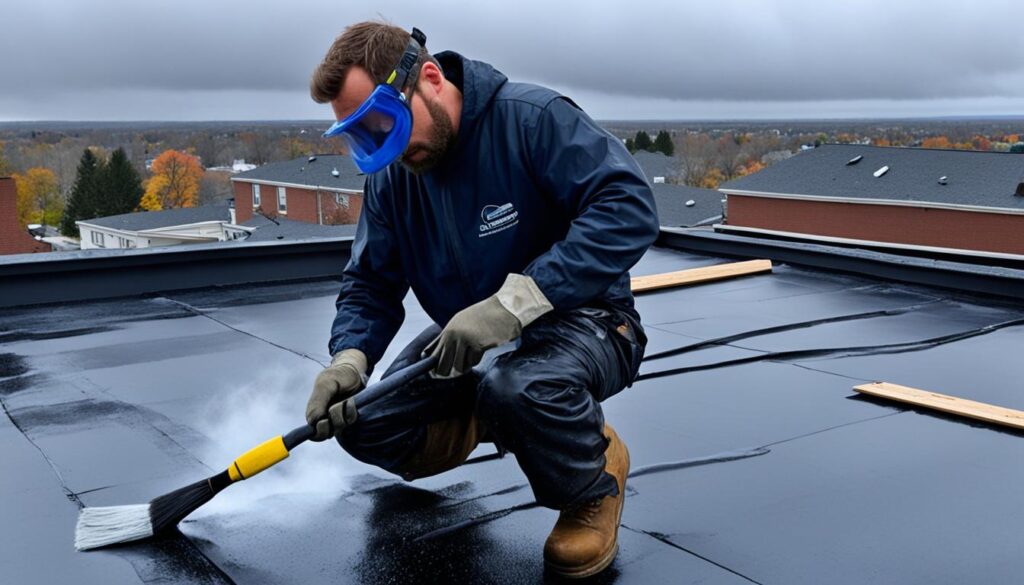
Roofing tar is often a cheaper option than standard asphalt shingles.1 This fact shows the value of roofing tar for protecting your home’s roof. It’s key for waterproofing your building. Liquid waterproofing is a common choice. It includes putting a coating on roofs, balconies, and other areas to keep water out.
Liquid waterproofing starts as a liquid and changes to a waterproof layer. It’s usually for roofs that are flat or have a low slope, as well as for balconies and terraces. Different ingredients like acrylics and polyurethane mix with solvents to make a liquid coating. This liquid hardens into a seamless barrier. This barrier stops water from getting in, keeping the building dry and safe.
Understanding Roofing Tar Paper
If you’re building or fixing a roof, you know what roofing tar paper is. It’s also called roofing felt or underlayment. This layer protects your roof against water, wind, and more. It goes under the shingles on top of the decking.
Types and Materials
There are three main types of roofing underlayment. They are asphalt-saturated felt, fiberglass-based tar paper, and synthetic underlayment.2 Asphalt-saturated felt is the most common. It’s made from materials like paper or rags, coated with asphalt to resist water.
2 Fiberglass-based tar paper combines fiberglass and asphalt for extra strength. It doesn’t tear easily, unlike traditional felt. Synthetic underlayment, made from materials like polypropylene, lasts longer. It fights off UV damage and other harm from the weather.
Installation Process
Installing roofing tar paper correctly is important. First, clean the roof well. Remove old materials and ensure the surface is even. Fix any leaks or damage before starting.
Layer the tar paper starting from the bottom and moving up. Overlap each layer slightly. You can also use self-adhering tar paper to skip nails or staples. If you’re using nails or staples, ensure they’re spaced out and secure to avoid leaks.2
Waterproofing with Roofing Tar
Benefits and Features
Tar paper is a top choice for waterproofing roofs. It protects roofs from rain, wind, and more. Its key benefit is keeping water out, which is vital in wet or snowy areas.1 It also fights off wind. Properly installed, it stops rain and wind from entering through the roof, avoiding leaks.
Moreover, it lasts long, saving you from constant repairs. This durability helps your roof stay strong over the years.
Considerations for Use
Choosing tar paper involves considering your local climate and regulations. For humid places, thicker tar paper is advisable.1 And if rain is common in your area, go for paper with a high coverage rating to fully protect your roof.
Check local building codes for specific tar paper requirements. This ensures your project meets all necessary standards. Then, look into costs. Even though it’s usually budget-friendly, prices can differ based on quality. Do a thorough cost analysis to pick the best one for your budget and needs.
Selection and Purchase
Thinking about quality is crucial when selecting tar paper. Start by looking at the paper’s weight and thickness. This is indicated by pounds per 100 square feet, with options usually ranging from #15 to #30.3 For areas with tough weather, heavier tar paper is better.
Next, consider the brand. Names like GAF, Owens Corning, and CertainTeed are well-known. Still, do your homework to find a trusted brand. It’s also good to get advice from a roofing expert to make the right choice for your project.

Conclusion
Roofing tar paper plays a key role in roof protection. It shields against water, wind, and more.4 These tar sheets can last 10-20 years, making them a smart choice for those watching their budget.4 Yet, they need regular checks for leaks and may not match all home styles.4 Their production has some impact on our planet, too.4
Choosing and using roofing tar involves understanding a few things.5 It is usually sold in 5-gallon containers and can last several years once properly used.5 It sets in a few hours but should not get wet for at least a day.5 It works on various roof types but needs a clean surface to stick well.5 Safety first: always use protective gear like gloves, goggles, and a mask when handling.
Roofing tar offers more than just roof protection. Its uses go from waterproofing basements to fixing gutter holes.5
Knowing about roofing tar paper helps homeowners and contractors pick the right waterproofing. This ensures your roof can fight water damage and last longer, protecting your home.
Recommended

Meet William Adams, a seasoned roofing expert with over 30 years of hands-on experience in the industry. Having worked tirelessly under the scorching sun and through the fiercest storms, William brings a wealth of knowledge and expertise to the table. Hailing from the heart of the USA, he’s witnessed the evolution of roofing practices firsthand, mastering every aspect along the way. Now retired from the field, William spends his days cherishing time with his loved ones while sharing his invaluable insights through this platform. With William at the helm, you can trust that every tip, advice, and recommendation provided is backed by years of real-world experience and unwavering dedication to quality craftsmanship. Join us as we journey through the world of roofing, guided by the wisdom and passion of a true industry veteran.
